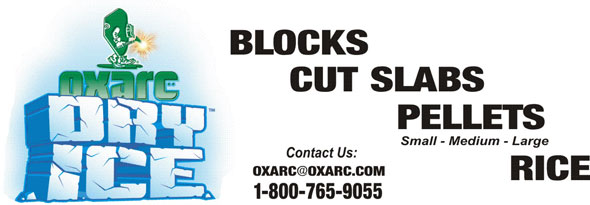

|
| DESCRIPTION |
|
Dry Ice is frozen or solid carbon dioxide, a colorless and odorless gas that is a normal part of our earth's atmosphere. It is the gas that we exhale during breathing and the gas that plants use in photosynthesis. It is also the same gas added to water to make soda water and carbonated beverages.
Dry ice keeps items colder for much longer than regular frozen water or “wet ice” because dry ice is extremely cold Dry Ice has a temperature of -109.3 degrees Fahrenheit (or -78.5 degrees Celsius). Dry Ice changes directly from a solid back to a gas, which is called “sublimating”, in normal atmospheric conditions without going through a wet liquid stage. Dry Ice is used for cooling or freezing and keeping things frozen because of this very cold temperature. It is also fairly simple to make and easy to handle using insulated gloves. (See “Safe Handling of Dry Ice”). |
| MAKING DRY ICE FROM CO2 GAS |
| To make dry ice, gaseous carbon dioxide (CO2) is first pressurized and refrigerated to form liquid CO2, which is allowed to expand in an atmospheric chamber. When CO2 converts from liquid to gas, there is an extreme drop in temperature. This causes some of the gas to freeze, yielding both snow-like CO2 and vapor CO2. The “snow” is then hydraulically pressed into dry ice blocks and pellets. Dry Ice is much heavier than traditional ice, weighing about double. Dry Ice machines are manufactured and available in all sizes and use liquid CO2 to produce the Dry Ice. Commercial machines use hydraulic presses to compress the Dry Ice snow with up to 60 Tons of pressure. It can produce a 55 pound block in less than 60 seconds. |
| FORMS OF DRY ICE |
|
BLOCKS are approximately 55 to 60 pounds each and usually measure 10’ X10” X 12”.
Cut Blocks or “SLABS” are approximately 10 pounds each and are usually 2” thick. PELLETS are usually produced in three sizes. SMALL, MEDIUM, and LARGE. Ranging in sizes approximately 1/8”, 1/4”, and 1/2”. |
| STORING, TRANSPORTING OR SHIPPING DRY ICE |
| Custom designed insulated containers are made specifically for transporting and storing Dry Ice. These containers come in a variety of sizes, shapes, and styles to accommodate a variety of short or long term storage applications and to maintain critical temperatures. They offer exceptional ergonomic design and outstanding durability. |



